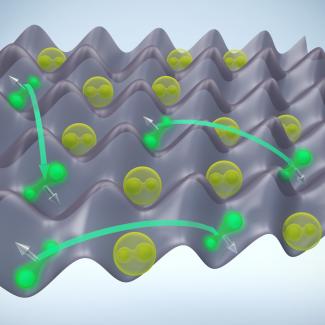New theory describing the spin behavior of ultracold polar molecules is opening the door to explorations of exciting, new physics in JILA’s cold molecular lab, operated by the Jin and Ye groups. According to the Rey theory group and its collaborators, ultracold dipolar molecules can do even more interesting things than swapping spins. For instance, spin swapping occurs naturally when ultracold potassium-rubidium (KRb) molecules are in two of their four possible excited and ground states. The differences in two states are sufficient to cause a spinning molecule to slow down at the same time another molecule begins to rotate.
The exciting news is that when two KRb molecules are in three of the four possible states, they don’t just swap their spins. The direction of the spin in the molecule that starts rotating gets reversed! This more elaborate spin swapping affects the motion of the molecules, a phenomenon known as spin-orbit coupling.
Spin-orbit coupling is something that happens in solids when electrons move inside the electric field of a crystal. This process is the key to understanding spin transport and spin currents, which are analogs of electron transport and electric currents. Spin-orbit coupling also plays a role in some very exotic phenomena such as the creation of a Majorana particle, which is its own antiparticle!
The theorists responsible for discovering these exciting new adventures in spin-orbit coupling are research associates Sergey Syzranov and Michael Wall, CU Associate Professor of Physics Victor Gurarie, and JILA Fellow Ana Maria Rey. Their discovery of spin-orbit coupling in ultracold molecules was reported online in Nature Communications on November 7, 2014.
The next step in this research is finding a model system for learning how to implement and control spin-orbit coupling. And, the JILA ultracold KRb experiment is ideally suited for this purpose. For example, KRb molecules are polar, which means that the K end of one molecule attracts the Rb end of another molecule, while two K ends or two Rb ends repel each other. These behaviors are known as dipole-dipole interactions. The new theory predicts that dipole-dipole interactions will spontaneously give rise to spin-orbit coupling in an ultracold gas of KRb molecules.
“The nice part is that with cold molecules, spin-orbit coupling just exists,” Rey explained. “We don’t need to zap anything with a laser to create it.”
Rey and her collaborators predict that spin-orbit coupling in ultracold polar molecules will generate excitations called chirons. Chirons are similar to the quasi particles found in bilayer graphene. They are expected to show up in the spin behaviors, spin currents, and spin interactions that occur in an ensemble of ultracold polar molecules pinned inside a deep optical lattice (a crystal of light created by intersecting laser beams). In other words, just about everything predicted by the new theory could soon be tested in the ultracold molecule laboratory in JILA! Stay tuned.—Julie Phillips




